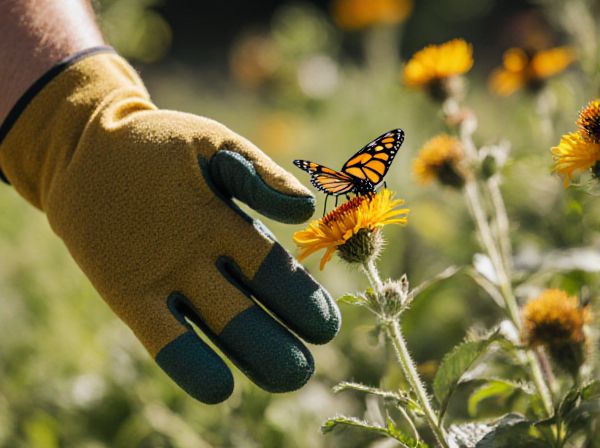
Pollinator garden vs Ornamental garden Illustration
Pollinator gardens prioritize native plants that provide nectar and pollen essential for bees, butterflies, and other pollinators, supporting biodiversity and ecosystem health. Ornamental gardens typically emphasize aesthetic appeal with a variety of decorative flowers, which may not always offer nutritional value to pollinators. Choosing a pollinator garden enhances habitat connectivity and promotes sustainable pollination services crucial for food production and wild plant reproduction.
Table of Comparison
| Feature | Pollinator Garden | Ornamental Garden |
|---|---|---|
| Purpose | Supports bees, butterflies, and other pollinators | Enhances visual appeal with decorative plants |
| Plant Types | Native wildflowers, nectar-rich plants | Exotic flowers, non-native species |
| Biodiversity | High biodiversity, promotes ecosystem health | Lower biodiversity, focused on aesthetics |
| Maintenance | Low to moderate, supports natural growth | Moderate to high, requires regular upkeep |
| Environmental Impact | Positive, enhances pollinator populations | Neutral to negative, may use chemicals |
| Water Usage | Typically low, drought-tolerant plants | Varies, often higher water demand |
Understanding Pollinator Gardens vs. Ornamental Gardens
Pollinator gardens are specifically designed to attract and support pollinators such as bees, butterflies, and hummingbirds by incorporating native flowering plants that provide nectar and pollen throughout the growing season. Ornamental gardens prioritize aesthetic appeal, featuring diverse plant species selected primarily for visual beauty, which may not offer the same ecological benefits as pollinator-friendly species. Understanding the distinction highlights the role of pollinator gardens in promoting biodiversity and ecosystem health compared to the decorative focus of ornamental gardens.
Key Differences in Purpose and Design
Pollinator gardens are specifically designed to support the needs of pollinators such as bees, butterflies, and hummingbirds by incorporating native flowering plants that provide nectar, pollen, and habitat throughout the growing season. Ornamental gardens primarily emphasize aesthetic appeal with a diverse selection of plants chosen for color, form, and texture, often including exotic species that may not offer ecological benefits to pollinators. Key differences lie in pollinator gardens promoting biodiversity and ecosystem health through purposeful plant selection and habitat creation, while ornamental gardens focus on visual beauty and landscape design without prioritizing ecological function.
Plant Selection: Native vs. Exotic Species
Pollinator gardens prioritize native plant species that provide essential nectar and pollen resources for local pollinators, enhancing biodiversity and ecosystem health. Ornamental gardens often feature exotic species selected for aesthetic appeal, which may lack the necessary nutritional value for pollinators and sometimes disrupt native pollination networks. Incorporating native plants in garden design supports specialized pollinators and promotes a balanced, resilient environment.
Garden Maintenance Requirements Compared
Pollinator gardens require less intensive maintenance than ornamental gardens due to their use of native plants that are well-adapted to local climates and soil conditions, reducing the need for frequent watering and fertilizers. Native wildflowers and perennials in pollinator gardens promote natural pest control, minimizing the use of pesticides compared to ornamental gardens that often rely on non-native, high-maintenance species. Regular pruning and deadheading are less critical in pollinator gardens since many native plants have natural growth cycles supporting pollinators, whereas ornamental gardens demand more consistent upkeep to maintain aesthetic appeal.
Wildlife Support and Environmental Impact
Pollinator gardens prioritize native flowering plants that provide vital nectar and pollen sources for bees, butterflies, and other wildlife, significantly enhancing biodiversity and ecosystem health. Ornamental gardens often emphasize aesthetic appeal with non-native species that may offer limited or no nutritional value to pollinators, resulting in reduced wildlife support and potential ecological imbalance. By fostering native plant communities, pollinator gardens contribute to improved soil quality, increased carbon sequestration, and greater resilience against environmental stressors compared to traditional ornamental landscapes.
Visual Appeal and Aesthetic Considerations
Pollinator gardens feature diverse native plants that create a dynamic, changing landscape rich in colors and textures, attracting butterflies, bees, and hummingbirds with vibrant blossoms and structural variety. Ornamental gardens often prioritize symmetry, uniformity, and non-native species for a controlled, manicured appearance that emphasizes decorative flowers and foliage over ecological function. While pollinator gardens offer seasonal visual interest and ecological benefits, ornamental gardens excel in structured beauty and maintenance ease, catering to different aesthetic goals.
Seasonal Interest and Year-Round Benefits
Pollinator gardens provide seasonal interest by attracting diverse pollinators through a variety of native flowering plants that bloom across spring, summer, and fall, supporting ecosystems year-round. These gardens offer continuous habitat and food sources for bees, butterflies, and other pollinators, enhancing biodiversity and improving crop pollination. In contrast, ornamental gardens often prioritize aesthetics with fewer native species and limited blooming periods, providing less sustained ecological value throughout the year.
Creating a Pollinator-Friendly Landscape
Pollinator gardens prioritize native flowering plants that provide nectar and pollen essential for bees, butterflies, and hummingbirds, enhancing local biodiversity and ecosystem health. In contrast, ornamental gardens often emphasize aesthetic appeal with non-native species that may lack nutritional value or bloom at limited times, reducing habitat support for pollinators. Creating a pollinator-friendly landscape involves selecting diverse, native plants that bloom sequentially to offer continuous forage and shelter throughout the growing season.
Sustainability and Eco-Friendly Practices
Pollinator gardens support biodiversity and enhance ecosystem services by providing native plants that attract essential pollinators like bees, butterflies, and hummingbirds, promoting sustainable habitats. In contrast, ornamental gardens often prioritize aesthetics with non-native species that may require extensive water, pesticides, and fertilizers, reducing ecological value and increasing environmental impact. Choosing pollinator gardens fosters eco-friendly practices by conserving water, reducing chemical use, and sustaining pollinator populations crucial for food production and plant reproduction.
Choosing the Right Garden for Your Space
Pollinator gardens prioritize native flowering plants that attract bees, butterflies, and other essential pollinators, enhancing biodiversity and supporting local ecosystems. Ornamental gardens focus on aesthetic appeal with diverse plant varieties, often including non-native species, which may not provide significant resources for pollinators. Selecting the right garden depends on your environmental goals: choose pollinator gardens for ecological benefits or ornamental gardens for decorative landscaping.
Pollinator garden vs Ornamental garden Infographic

 gardendif.com
gardendif.com